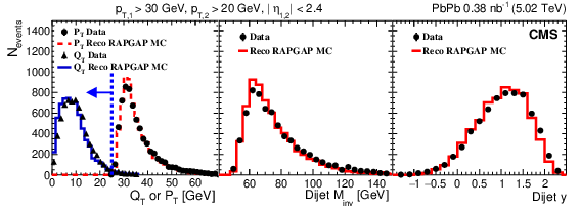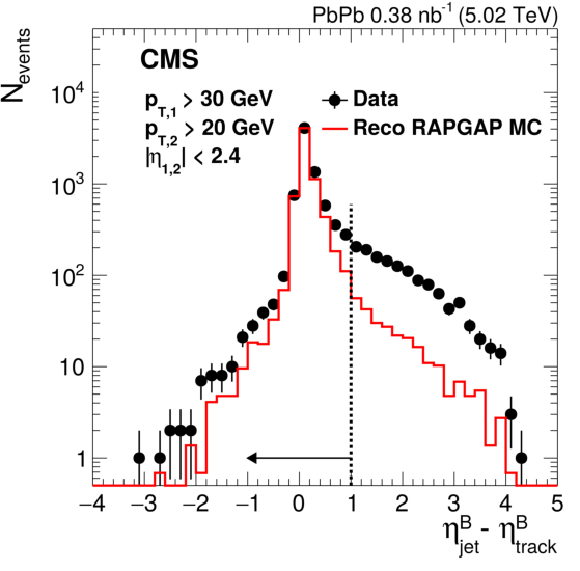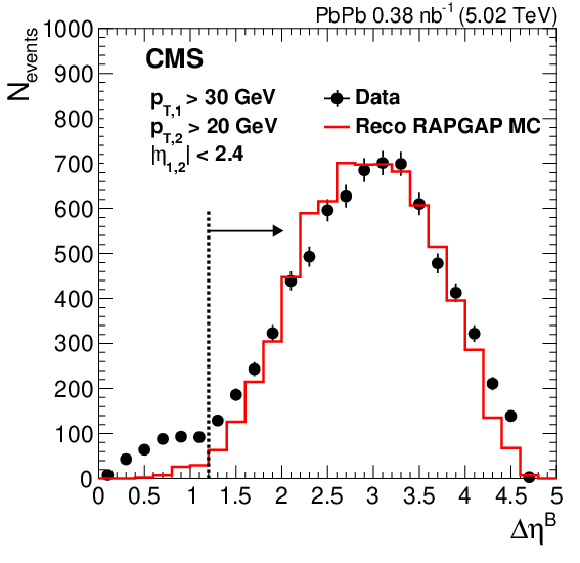

Compact Muon Solenoid
LHC, CERN
| CMS-HIN-18-011 ; CERN-EP-2021-071 | ||
| Azimuthal Correlations within Exclusive Dijets with Large Momentum Transfer in Photon-Lead Collisions | ||
| CMS Collaboration | ||
| 29 April 2022 | ||
| Phys. Rev. Lett. 131 (2023) 051901 | ||
| Abstract: The structure of nucleons is multidimensional and depends on the transverse momenta, spatial geometry, and polarization of the constituent partons. Such a structure can be studied using high-energy photons produced in ultraperipheral heavy-ion collisions. The first measurement of the azimuthal angular correlations of exclusively produced events with two jets in photon-lead interactions at large momentum transfer is presented, a process that is considered to be sensitive to the underlying nuclear gluon polarization. This study uses a data sample of ultraperipheral lead-lead collisions at $ \sqrt{\smash[b]{s_{_{\mathrm{NN}}}}} = $ 5.02 TeV, corresponding to an integrated luminosity of 0.38 nb$^{-1}$, collected with the CMS experiment at the LHC. The measured second harmonic of the correlation between the sum and difference of the two jet transverse momentum vectors is found to be positive, and rising, as the dijet transverse momentum increases. A well-tuned model that has been successful at describing a wide range of proton scattering data from the HERA experiments fails to describe the observed correlations, suggesting the presence of gluon polarization effects. | ||
| Links: e-print arXiv:2205.00045 [hep-ex] (PDF) ; CDS record ; inSPIRE record ; HepData record ; CADI line (restricted) ; | ||
| Figures & Tables | Summary | Additional Figures | References | CMS Publications |
|---|
| Figures | |

png pdf |
Figure 1:
Magnitudes of the vector sum ($ Q_{\mathrm{T}} $) and vector difference ($ P_{\mathrm{T}} $) of the two jets (left). The dashed blue line illustrates the $ Q_{\mathrm{T}} < $ 25 GeV requirement. Invariant mass (center) and rapidity (right) of the dijet candidates after all selection requirements. The lines show the RAPGAP MC generated events including detector resolution effects. The statistical uncertainties are covered by the symbol size. |

png pdf |
Figure 2:
The unfolded 1 $ /{N_{\text{events}}} \,\mathrm{d} N/\mathrm{d}\Phi $ distribution (left) and the unfolded $ \langle \cos(2\Phi) \rangle $ values as a function of $ Q_{\mathrm{T}} $ (right). The corresponding distributions from the RAPGAP simulation at the generator level (blue lines) and theoretical calculation by Hatta \textitet al. $ \mbox{et al.} $ [20] for $ \langle \cos(2\Phi) \rangle $ (red dashed lines) are also shown for $ Q_{\mathrm{T}} < $ 15 GeV, consistent with the back-to-back limit in their calculation. The dijet events are found predominantly in the forward direction, with $ {0 < \eta_\text{jet} < 2.4} $. Both the statistical (error bars) and systematic (green boxes) uncertainties are shown. |

png pdf |
Figure 2-a:
The unfolded 1 $ /{N_{\text{events}}} \,\mathrm{d} N/\mathrm{d}\Phi $ distribution. The corresponding distributions from the RAPGAP simulation at the generator level (blue lines) and theoretical calculation by Hatta et al. [20] for $ \langle \cos(2\Phi) \rangle $ (red dashed lines) are also shown for $ Q_{\mathrm{T}} < $ 15 GeV, consistent with the back-to-back limit in their calculation. The dijet events are found predominantly in the forward direction, with $ {0 < \eta_\text{jet} < 2.4} $. Both the statistical (error bars) and systematic (green boxes) uncertainties are shown. |

png pdf |
Figure 2-b:
The unfolded $ \langle \cos(2\Phi) \rangle $ values as a function of $ Q_{\mathrm{T}} $. The corresponding distributions from the RAPGAP simulation at the generator level (blue lines) and theoretical calculation by Hatta et al. [20] for $ \langle \cos(2\Phi) \rangle $ (red dashed lines) are also shown for $ Q_{\mathrm{T}} < $ 15 GeV, consistent with the back-to-back limit in their calculation. The dijet events are found predominantly in the forward direction, with $ {0 < \eta_\text{jet} < 2.4} $. Both the statistical (error bars) and systematic (green boxes) uncertainties are shown. |
| Tables | |

png pdf |
Table of $ \langle \cos(2\Phi) \rangle $ systematic uncertainties (absolute values). The individual components are discussed in the text. :
|
| Summary |
| In summary, the exclusive production of two jets in photon-lead interactions with a large rapidity gap has been studied for the first time. The dijet events are characterized by a large momentum transfer. The second harmonic of the angular correlation between the sum and difference of the two jet transverse momenta is found to be positive and rising, with dijet transverse momentum in the measured range 0–25 GeV. An a posteriori calculation that includes the effect of soft gluons from final-state radiation describes the average magnitude of the correlations, but does not rise with the magnitude of the dijet total momentum $ Q_\text{T} $ to the extent found with the CMS data. A model [41] that has been successful at describing a wide range of proton scattering data from the HERA experiments overestimates the strength of the correlations, suggesting the presence of gluon polarization effects. This experiment calls for new theoretical calculations to quantify the theoretical implications and opens a new direction for probing the high-energy limit of strong interactions. |
| Additional Figures | |

png pdf |
Additional Figure 1:
Difference in pseudorapidity between the most backward jet in an event and the most backward track defining the backward rapidity gap, $\eta _{\text {jet}}^{B} - \eta _{\text {track}}^{B}$, shown for data and reconstructed rapgap MC events. The dashed line with the arrow corresponds to the selection applied in the analysis that this difference should be less than 1. |

png pdf |
Additional Figure 2:
Backward rapidity gap, $\Delta \eta ^{B}$, defined as the difference between the minimum pseudorapidity of any high-purity charged track having $ {p_{\mathrm {T}}} > $ 0.2 GeV and the lower limit of the tracker shown for data and reconstructed rapgap MC events. The dashed line with the arrow corresponds to the selection $\Delta \eta ^{B} > $ 1.2 applied in the analysis. |

png pdf |
Additional Figure 3:
Correlation of the magnitudes of the vector sum ($Q_{\mathrm {T}}$) and vector difference ($P_{\mathrm {T}}$) of the two jets for the events that pass the selection criteria. |

png pdf |
Additional Figure 4:
The $\mathrm{d}N/\mathrm{d}\Phi $ distribution shown for the mixed events obtained from data and compared to the rapgap MC prediction after full simulation and reconstruction (blue line). Both the statistical (error bars) and systematic (magenta boxes) uncertainties are shown. Dashed histograms show the toy-MC distribution including the effect of detector smearing. |

png pdf |
Additional Figure 5:
The second harmonic, $\langle \cos(2\Phi) \rangle $, as a function of $Q_{\mathrm {T}}$ shown for the mixed events obtained from data and compared to the rapgap MC prediction after full simulation and reconstruction (blue line). Both the statistical (error bars) and systematic (magenta boxes) uncertainties are shown. Dashed histograms show the toy-MC distribution including the effect of detector smearing. |
| References | ||||
| 1 | J. L. Albacete and C. Marquet | Gluon saturation and initial conditions for relativistic heavy ion collisions | Prog. Part. NP 76 (2014) 1 | 1401.4866 |
| 2 | R. Abdul Khalek et al. | Science requirements and detector concepts for the Electron-Ion Collider: EIC yellow report | 2103.05419 | |
| 3 | BRAHMS Collaboration | Evolution of the nuclear modification factors with rapidity and centrality in dAu collisions at $ {\sqrt {\smash [b]{s_{_{\mathrm {NN}}}}}} = $ 200 GeV | PRL 93 (2004) 242303 | nucl-ex/0403005 |
| 4 | STAR Collaboration | Forward neutral pion production in pp and dAu collisions at $ {\sqrt {\smash [b]{s_{_{\mathrm {NN}}}}}} = $ 200 GeV | PRL 97 (2006) 152302 | nucl-ex/0602011 |
| 5 | PHENIX Collaboration | Suppression of back-to-back hadron pairs at forward rapidity in dAu collisions at $ {\sqrt {\smash [b]{s_{_{\mathrm {NN}}}}}} = $ 200 GeV | PRL 107 (2011) 172301 | 1105.5112 |
| 6 | PHOBOS Collaboration | High transverse momentum triggered correlations over a large pseudorapidity acceptance in AuAu collisions at $ {\sqrt {\smash [b]{s_{_{\mathrm {NN}}}}}} = $ 200 GeV | PRL 104 (2010) 062301 | 0903.2811 |
| 7 | M. Diehl | Introduction to GPDs and TMDs | EPJA 52 (2016) 149 | 1512.01328 |
| 8 | T. Altinoluk, N. Armesto, G. Beuf, and A. H. Rezaeian | Diffractive dijet production in deep inelastic scattering and photon-hadron collisions in the color glass condensate | PLB 758 (2016) 373 | 1511.07452 |
| 9 | Y. Hatta, B.-W. Xiao, and F. Yuan | Probing the small-x gluon tomography in correlated hard diffractive dijet production in deep inelastic scattering | PRL 116 (2016) 202301 | 1601.01585 |
| 10 | Y. Hagiwara et al. | Accessing the gluon Wigner distribution in ultraperipheral pA collisions | PRD 96 (2017) 034009 | 1706.01765 |
| 11 | Y. Hatta, B.-W. Xiao, and F. Yuan | Gluon tomography from deeply virtual Compton scattering at small-x | PRD 95 (2017) 114026 | 1703.02085 |
| 12 | H. Mantysaari, N. Mueller, and B. Schenke | Diffractive dijet production and Wigner distributions from the color glass condensate | PRD 99 (2019) 074004 | 1902.05087 |
| 13 | A. Dumitru, V. Skokov, and T. Ullrich | Measuring the Weizsacker-Williams distribution of linearly polarized gluons at an electron-ion collider through dijet azimuthal asymmetries | PRC 99 (2019) 015204 | 1809.02615 |
| 14 | Y. Hagiwara, Y. Hatta, and T. Ueda | Wigner, Husimi, and generalized transverse momentum dependent distributions in the color glass condensate | PRD 94 (2016) 094036 | 1609.05773 |
| 15 | Y. Hagiwara, Y. Hatta, B.-W. Xiao, and F. Yuan | Elliptic flow in small systems due to elliptic gluon distributions? | PLB 771 (2017) 374 | 1701.04254 |
| 16 | J. Zhou | Elliptic gluon generalized transverse-momentum-dependent distribution inside a large nucleus | PRD 94 (2016) 114017 | 1611.02397 |
| 17 | M. Strikman, R. Vogt, and S. N. White | Probing small-x parton densities in ultraperipheral AA and pA collisions at the CERN Large Hadron Collider | PRL 96 (2006) 082001 | hep-ph/0508296 |
| 18 | V. Guzey and M. Klasen | Diffractive dijet photoproduction in ultraperipheral collisions at the LHC in next-to-leading order QCD | JHEP 04 (2016) 158 | 1603.06055 |
| 19 | P. Kotko et al. | Estimating nonlinear effects in forward dijet production in ultra-peripheral heavy ion collisions at the LHC | EPJC 77 (2017) 353 | 1702.03063 |
| 20 | Y. Hatta, B.-W. Xiao, F. Yuan, and J. Zhou | Anisotropy in dijet production in exclusive and inclusive processes | PRL 126 (2021) 142001 | 2010.10774 |
| 21 | A. J. Baltz et al. | The physics of ultraperipheral collisions at the LHC | PR 458 (2008) 1 | 0706.3356 |
| 22 | J. G. Contreras and J. D. Tapia Takaki | Ultra-peripheral heavy-ion collisions at the LHC | Int. J. Mod. Phys. A 30 (2015) 1542012 | |
| 23 | S. Klein and P. Steinberg | Photonuclear and two-photon interactions at high-energy nuclear colliders | Ann. Rev. Nucl. Part. Sci. 70 (2020) 323 | 2005.01872 |
| 24 | CMS Collaboration | Coherent J/$\psi$ photoproduction in ultra-peripheral PbPb collisions at $ {\sqrt {\smash [b]{s_{_{\mathrm {NN}}}}}} = $ 2.76 TeV with the CMS experiment | PLB 772 (2017) 489 | CMS-HIN-12-009 1605.06966 |
| 25 | CMS Collaboration | Measurement of exclusive $ \rho(770) $ photoproduction in ultraperipheral pPb collisions at $ {\sqrt {\smash [b]{s_{_{\mathrm {NN}}}}}} = $ 5.02 TeV | EPJC 79 (2019) 702 | CMS-FSQ-16-007 1902.01339 |
| 26 | CMS Collaboration | Measurement of exclusive $ \Upsilon $ photoproduction from protons in pPb collisions at $ {\sqrt {\smash [b]{s_{_{\mathrm {NN}}}}}} = $ 5.02 TeV | EPJC 79 (2019) 277 | CMS-FSQ-13-009 1809.11080 |
| 27 | CMS Collaboration | Evidence for light-by-light scattering and searches for axion-like particles in ultraperipheral PbPb collisions at $ {\sqrt {\smash [b]{s_{_{\mathrm {NN}}}}}} = $ 5.02 TeV | PLB 797 (2019) 134826 | CMS-FSQ-16-012 1810.04602 |
| 28 | ALICE Collaboration | Coherent J/$\psi$ photoproduction in ultra-peripheral PbPb collisions at $ {\sqrt {\smash [b]{s_{_{\mathrm {NN}}}}}}= $ 2.76 TeV | PLB 718 (2013) 1273 | 1209.3715 |
| 29 | ATLAS Collaboration | Observation of light-by-light scattering in ultraperipheral PbPb collisions with the ATLAS detector | PRL 123 (2019) 052001 | 1904.03536 |
| 30 | LHCb Collaboration | Central exclusive production of J/$\psi$ and $\psi$(2S) mesons in pp collisions at $ \sqrt{s}= $ 13 TeV | JHEP 10 (2018) 167 | 1806.04079 |
| 31 | CDF Collaboration | Observation of exclusive dijet production at the fermilab tevatron $ \mathrm{p\bar{p}} $ collider | PRD 77 (2008) 052004 | 0712.0604 |
| 32 | ZEUS Collaboration | Production of exclusive dijets in diffractive deep inelastic scattering at HERA | EPJC 76 (2016) 16 | 1505.05783 |
| 33 | CMS Collaboration | HEPData record for this analysis | link | |
| 34 | CMS Collaboration | The CMS trigger system | JINST 12 (2017) P01020 | CMS-TRG-12-001 1609.02366 |
| 35 | CMS Collaboration | The CMS experiment at the CERN LHC | JINST 3 (2008) S08004 | CMS-00-001 |
| 36 | CMS Collaboration | Constraining gluon distributions in nuclei using dijets in proton-proton and proton-lead collisions at $ \sqrt {\smash [b]{s_{_{\mathrm {NN}}}}} = $ 5.02 TeV | PRL 121 (2018) 062002 | CMS-HIN-16-003 1805.04736 |
| 37 | CMS Collaboration | Particle-flow reconstruction and global event description with the CMS detector | JINST 12 (2017) P10003 | CMS-PRF-14-001 1706.04965 |
| 38 | M. Cacciari, G. P. Salam, and G. Soyez | The anti-$ {k_{\mathrm{T}}} $ jet clustering algorithm | JHEP 04 (2008) 063 | 0802.1189 |
| 39 | M. Cacciari, G. P. Salam, and G. Soyez | FastJet user manual | EPJC 72 (2012) 1896 | 1111.6097 |
| 40 | CMS Collaboration | CMS tracking performance results from early LHC operation | EPJC 70 (2010) 1165 | CMS-TRK-10-001 1007.1988 |
| 41 | H. Jung | Hard diffractive scattering in high-energy ep collisions and the Monte Carlo generator RAPGAP | CPC 86 (1995) 147 | |
| 42 | S. R. Klein et al. | STARlight: A Monte Carlo simulation program for ultra-peripheral collisions of relativistic ions | Comput. Phys. Commun. 212 (2017) 258 | 1607.03838 |
| 43 | GEANT4 Collaboration | GEANT4: A simulation toolkit | NIMA 506 (2003) 250 | |
| 44 | S. R. Klein and H. Mantysaari | Imaging the nucleus with high-energy photons | Nature Rev. Phys. 1 (2019) 662 | 1910.10858 |
| 45 | S. Schmitt | TUnfold: an algorithm for correcting migration effects in high energy physics | JINST 7 (2012) T10003 | 1205.6201 |
| 46 | CMS Collaboration | Jet energy scale and resolution in the CMS experiment in pp collisions at 8 TeV | JINST 12 (2017), no. 02, P02014 | CMS-JME-13-004 1607.03663 |
| 47 | A. van Hameren, P. Kotko, K. Kutak, and S. Sapeta | Broadening and saturation effects in dijet azimuthal correlations in pp and pPb collisions at $ \sqrt{s} = $ 5.02 TeV | PLB 795 (2019) 511 | 1903.01361 |

|
Compact Muon Solenoid LHC, CERN |

|

|

|

|

|

|